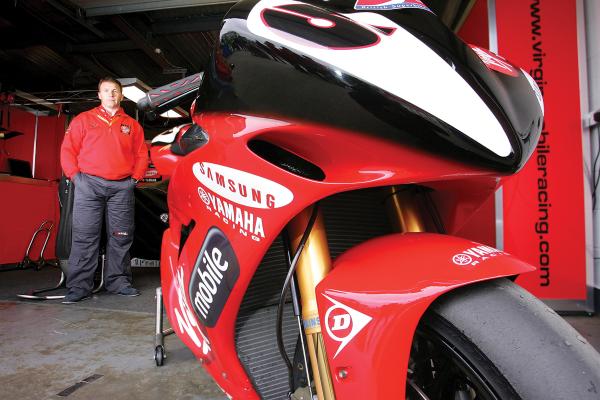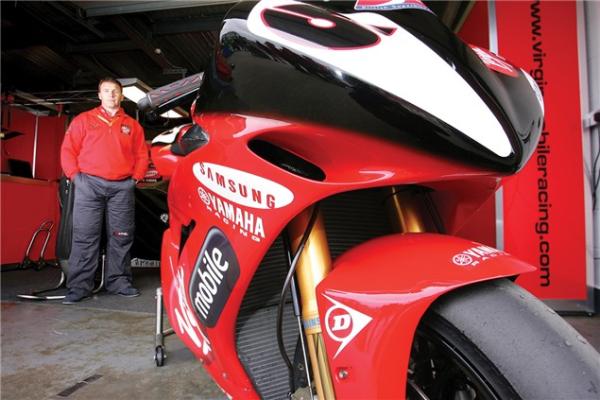Big Bang Theory - Virgin Yamaha R1
Big bang motors have arrived in BSB. Virgin Yamaha's R1 breaks the mould, not the rules
At the beginning of 2004 a new sound was heard in MotoGP. The screaming rasp of the inline four-cylinder Yamaha M1 was replaced with a deeper, flat drone, which at tickover became a rough, barking clatter. Yamaha had introduced the 'big bang' concept to the world.
Now the same sound can be heard in the UK, thanks to the out-on-a-limb inspiration of Rob McElnea's Virgin Mobile Yamaha team. Nicknamed the Scunthorpe Pig, Rob's big bang R1 has spiced up the British Superbike mix, generating interest from around the world.
But it wasn't just done for the publicity. Like the Yamaha MotoGP team before them, the Virgin Mobile squad recognised a need for a different approach to producing power from their screaming inline four-cylinder motor.
"We knew from half-way through 2004 that the bike was a bit awkward," explains Rob Mac. "We looked everywhere to get the bike softer, but now we know how much the engine was affecting the chassis and tyres. The way the power was delivered caused so many problems."
The idea to build the motor belonged to Virgin's engine man Kev Stevenson, and it was a plan he'd been mulling over since 2000 when the team was running R7s. But it wasn't until May last year that he got the new camshafts made - the key component in the big bang R1 motor.
"We've had the new engine since then," explains Kev, "but we'd only run it on the dyno. Me and Rob had been talking about the Pig, so when we signed Sean Emmett we took it to Croft for him to have a go. We were half expecting him to do a lap and come in and say it's rubbish, but he went out and did his first lap, then another, and another. It was a bit flat here and there, but we hadn't done much work on the engine so we decided to improve it.
"We played about with a lot of things, then we went to Almeria and Sean was over a second faster within three laps. He loved it. It gave him the confidence to carry more speed into the turn, and he gained all his time there. It seems big bang engines are much easier on the way into corners, though there's no reason they should be."
Rob Mac again: "It's a different bike, we've gained so much entering corners. Now we can see how Rossi rides his bike the way he does. You've got to be able to do things the telemetry says you can't, and Sean's now got a bike he can be the boss of."
What's remarkable is how little has been traded off. Rob says they decided early on to forsake 10 or 15bhp to get the bike working. Convention says the increased mid-range should be at the expense of top end - it's estimated Rossi's M1 has been up to 15kmh down on the Hondas at faster circuits - but the Virgin R1 has barely lost out. Kev admits the motor is 'a little bit' down on their best-ever screamer, but they're up on power compared to last year's bike and have gained 40bhp since the big bang motor was first run.
"There are no negatives," insists Rob. "We went half-way round the world looking for negatives and didn't find any. Igor Akrapovic said it was one of the best superbikes he'd ever had on his dyno."
Equally remarkable is that the Virgin bike has been developed entirely within superbike regulations. "The MCRCB [Motorcycle Racing Control Board, BSB's rule makers] were our first call," says Rob. "And we're well within the rules." BSB regs say camshafts are 'free', ie they can be completely changed from stock so, as this is the only component to change, the motor can be converted from screamer to Pig without breaking the rules.
But while BSB welcomes the project, World Superbike boss Paolo Flammini has taken an instant dislike to the idea, and the FIM has voted to ban big bang engine developments in World Supers. The Yamaha Italia team had certainly taken an interest in the project, sending riders Andrew Pitt and Nori Haga to test ride the Virgin bike at Almeria earlier this year but, whether they liked it or not, they won't be riding one in World Superbikes.
Back in the UK, development of the Virgin bikes continues after promising early results, despite Emmett riding injured from the first round at Brands.
"There's still more to come," says Kev. "People have said that Suzuki are going to do it, Honda are going to do it, but it's taken us six months to get here. It's not just a matter of building an engine with new camshafts. If it was that easy everybody would be doing it."
WHITHAM RIDES THE PIG
It's been seven years since I've ridden a full-blown superbike, so you can imagine how giddy I was to be packed off to Almeria to have a go on the Virgin Mobile Yamaha big bang R1.
To get a feel for things I first went out on the R1 as it finished last season. Almeria is twisty and it was physically and mentally demanding riding the 'screamer'. Your time is spent stopping it kicking sideways, keeping the front wheel down and generally clinging on and sweating a lot. It's easy to understand the problems you'd face pushing this bike to the limit. To carry any corner speed it's necessary at some point to open the throttle with the bike on its side and the tyres already close to the limit. Unless you're super careful tapping the throttle on it's very easy to have a tyre-mincing slide or a trip over the highside. Rob says his riders have always been able to put one or two laps in on qualifying tyres because the extra grip allows them to open the gas earlier, but on standard rubber you compensate for the lack of mid-corner confidence by going into turns slower, rolling round the mid-section and sitting the bike up before opening the throttle.
Now for the Pig. This is essentially similar to screamer: same weight distribution, same gearing, same suspension set-up, everything except the cam shaft and engine management.
On track the main difference is the confidence the engine gives to get on the throttle mid-corner; there's a more direct connection to the rear wheel. Because of the wider spread of power the Pig actually feels slower than the screamer. It isn't. The extra mid-range lets you pull a higher gear round some corners. I was taking the final turn in second on the screamer, which meant changing gear while still leant over. On the pig I could take it in third, no problem.
The engine note is so different it was hard to know when to change gear. Both motors top out at 13,000 rpm but on the screamer you could feel all those revs. On the Pig you'd think it was only revving at half that.
The more laps I did, the more ways I found to go quicker. Once you realise you can open the gas in the corner more safely, you instinctively run in quicker and carry more speed through the turn.
Overall I had more time to think about what I was doing and physically it was less effort to go quicker - I knocked over a second off my times in 10 laps. It should also give the tyres an easier time and allow riders to maintain their pace towards the end of a race. It's also going to be better in the wet where having a better feel for how much traction you have is even more important.











